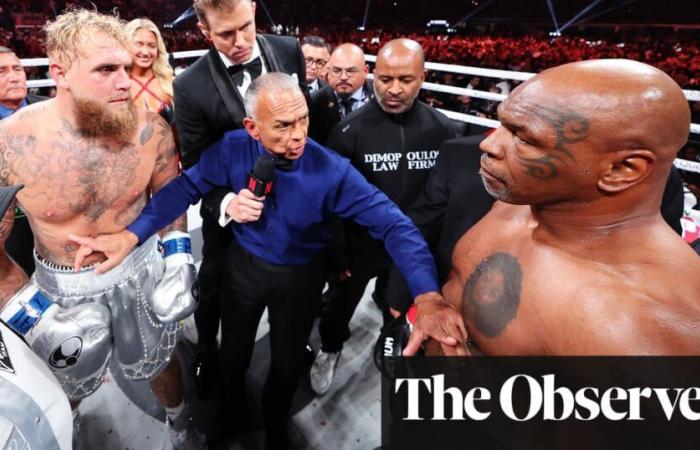
Mike Tyson’s return to professional boxing after nearly two decades generated considerable public attention before Friday night’s comeback fight against the YouTuber-turned-boxer Jake Paul, but the reviews were not kind.
The 58-year-old former heavyweight champion’s lamentable performance in a dull defeat by a unanimous decision elicited disappointment and condemnation as boos rained down from the crowd of more than 72,000 spectators at AT&T Stadium in Arlington, Texas, about 20 miles west of Dallas.
“Just sad,” NBA legend Earvin “Magic” Johnson wrote. “I cut it off because I couldn’t watch anymore. It’s sad to see Mike Tyson like this because I went to every Tyson fight. This fight tonight was not great for boxing.”
Tyson connected with a scant 18 punches over the eight two-minute rounds, including just six over the last five sessions, compared with his opponent’s 78 landed blows. Wearing a compression sleeve on his right knee, he appeared completely exhausted after the first round, with his movement visibly hampered, leaving the 27-year-old Paul to score at will with outside jabs.
“I love Mike Tyson, but [commentators are] giving him too much credit,” the four-weight boxing champion Terence Crawford wrote. “He looked like trash, to train that long and only throw 97 punches the whole fight is crazy. I’m just glad he didn’t get hurt out there.”
The 31-year age gap between the fighters was thought to be the largest in history, eclipsing the 24 years that separated Archie Moore and Mike DiBiase when they met as light heavyweights in 1963. And Tyson looked every bit the part of a man pushing 60 with a history of health issues and coming off a 7,097-day layoff as he laboured through eight dreary rounds, the spirit willing but the body in full rebellion.
“Mad at myself for staying awake for that,” former NFL star and Burnley FC minority investor JJ Watt wrote. “I know better.”
Audible jeers could be heard throughout the $1.2bn (£951m) home of the NFL’s Dallas Cowboys during the later rounds as Paul eased up on his punches, sensing Tyson was fatigued and vulnerable and sparing him the humiliation of a knockout that seemed ripe for the picking.
Paul said: “I wanted to give the fans a show but I didn’t want to hurt somebody that didn’t need to be hurt.”
The criticism was not limited to the dismal main event. The seven-fight card marked Netflix’s third foray into live sports after last year’s The Netflix Cupa golf pro-am with F1 drivers, and March’s The Netflix Slama tennis exhibition between Carlos Alcaraz and Rafael Nadal in Las Vegas. But the enormous popularity of Paul and Tyson, with divergent age demographics, helped attract a massive global audience that overwhelmed the company’s servers, resulting in thousands of complaints from viewers about buffering problems and frozen screens.
The technical issues began during the co-feature bout, which saw Katie Taylor win a disputed 10-round unanimous decision over Amanda Serrano in a much-anticipated rematch of their 2022 classic. The crowd-pleasing scrap offered a stark contrast with the dour main event, but not for the nearly 100,000 users who reported network issues starting in the middle rounds, according to the website Downdetector.
Those problems would persist into Tyson’s fight with Paul, driving many viewers to X and Bluesky to vent their frustrations, where #NetflixCrash was among the trending topics.
after newsletter promotion
“Hey Netflix, have you tried unplugging and replugging the router?” one X user wrote .
By many metrics the event, promoted by Paul’s three-year-old Most Valuable Promotions company, was a roaring success. The live gate of nearly $18m (£14.3m) shattered the record for the largest US boxing gate outside of Las Vegas and nearly doubled the previous Texas mark for a boxing or MMA (mixed martial arts) event of $9m for Canelo Álvarez’s fight with Billy Joe Saunders in 2021.
“This is the biggest event,” Paul later boasted. “Over 120 million people on Netflix. We crashed the site.”
But it was a rocky showing for the streamer, whose live sports ambitions are central to its plans for growing its nascent advertising business. Netflix will broadcast two NFL games over Christmas and will begin streaming World Wrestling Entertainment’s Raw franchise in January as part of a 10-year, $5bn deal signed this year.





